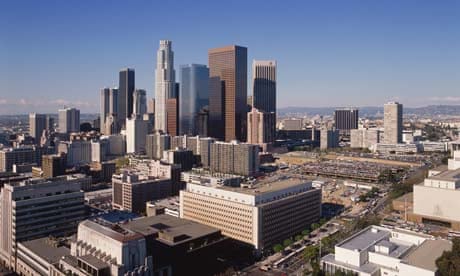Because we've all grown up seeing the tanned, supple bodies of Los Angeles splashed across our TV and cinema screens, it's easy to make the mistake of thinking we know the city intimately. But take it from Kim Cooper and Richard Schave - native Angelenos and principals of Esotouric, the bus adventure company that delves deep into the city's secret heart - the real Los Angeles remains a beautiful enigma.
Esotouric's bus tours are dedicated to discovering these elusive locations and putting them into a cultural context - the secret power spots where pop culture moments fizzed into life, where great writers found their muses and where incredibly strange happenings gave everyday places cult status.
We caught up with them, and convinced them to divulge their top 10 spots:
1. Musso & Frank Grill

As the oldest restaurant in Hollywood, Musso-Frank (as regulars over 60 call it) has seen the neighbourhood slowly morph from glitz to sleaze, and now its current slouch towards hipster respectability. But it has never wavered in its dedication to serving steaks and gimlets, just as Raymond Chandler's heroic detective Philip Marlowe liked 'em. A meal here remains a rare chance to take your eyes and tummy on a time-travel trip, all the while musing that Fitzgerald, Faulkner, Hemingway and Parker once chewed the fat in the private Writer's Room. Raymond Chandler penned The Big Sleep in the back room of the Stanley Rose Book Shop, which was annexed for the grill's 1950s-era "new room". In the 1980s, Charles Bukowski spent his royalties here, and his favourite bartender, Ruben, on duty whenever the bar is open, is usually good for a Buk anecdote. Best deal: before 3pm, try the flannel cakes, LA's most perfect pancake.
· Musso & Frank Grill, 6667 Hollywood Boulevard, Los Angeles, CA 90028; +1 (323) 467-7788
2. Biltmore Hotel
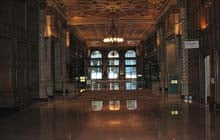
In the 1980s, this grand 1920s hotel built a new lobby facing the Central Library, because the view of Pershing Square's lowlife from Olive Street had become too seedy for the guests. The old Olive Street lobby was famously the second-to-last place Beth "Black Dahlia" Short was seen before her January 1947 murder (see Club Galaxy below), but less well-known is the role the lobby played in a blackmarket adoption racket, which provided stolen Tennessee tykes to Hollywood stars, who'd pick up their new babes here. If Joan Crawford had been able to see what was coming, she might have thought twice about little Biltmore adoptee (and later author of the poison-pen bestseller Mommie Dearest) Christina Crawford. Today you can take afternoon tea in the restored historic lobby, or ironically enjoy a Black Dahlia cocktail in the upstairs bar, while marvelling at one of the most exquisite rococo interiors anywhere.
· Millennium Biltmore Hotel, 506 South Grand Avenue, Los Angeles, CA 90071; +1 (213) 624-1011; millenniumhotels.com
3. Canter's Deli
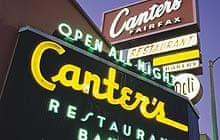
Hollywood fixture Canter's rode the wave of Jewish migration from Boyle Heights to the Fairfax district in 1948, but would have long since switched off its quirky neon baker sign had the management not opened the doors to the hippy set in the 1960s. When Sunset Strip businessmen and cops were cracking down on long-haired kids, Canter's rolled out the welcome mat. From Frank Zappa and the Mothers to the Germs, the late-night bagels, steaming bowls of matzoh ball soup and arch remarks from waitresses have all kept the counterculture humming. These days, you can count on finding legendary DJ Rodney "On the Rock" Bingenheimer dining nightly in the booth with his name on it (courtesy of his pal Nancy Sinatra). One night, an altercation down the road at the Troubadour continued here, with members of Tom Waits' entourage exchanging volleys of pastry and deli food with a gang of punks from East LA.
· Canter's Delicatessen and Restaurant, 419 North Fairfax Avenue, Los Angeles, California 90036; +1 (323) 651 2030; cantersdeli.com
4. Clifton's Cafeteria
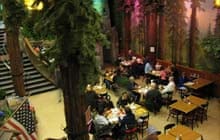
In 1931, in the depths of the Depression, restaurateur Clifford Clinton opened his first downtown eatery, a homey place where empty pockets never kept a guest from leaving with a full stomach. His second venture, Clifton's Brookdale (1935), survives as an astonishing woodland fantasia of faux redwood trunks, babbling brooks, giant moose heads and cherry Jell-o dotted with canned fruit nuggets. Before grabbing a tray and filling it with comfort food, stop by the modest stone chapel on the mezzanine, and listen to a recorded voice musing on the magic to be found in the woods. A young Ray Bradbury (later author of The Martian Chronicles and Farenheit 451) attended science-fiction club meetings under the moose head. Be sure to trek upstairs to the red room, lined with vintage memorabilia and the original blueprints for the Sherbert Mine, a strange contraption that delivered ice-cream scoops from the basement.
· Clifton's Brookdale, 648 South Broadway, Los Angeles, CA 90014; +1 (213) 627 1673; cliftonscafeteria.com
5. Vito's Studio
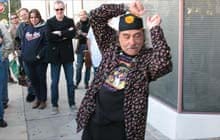
In the early 1960s, these modest art-deco storefronts were the starting point for a social, musical, artistic and fashion revolution spearheaded by Vito Paulekas, a 50-something sculptor and dancer. The community of self-professed "freaks" that formed around Vito, his fashion designer wife Szou and court jester Carl "Captain Fuck" Franzoni, included a who's who of 60s youthquakers: The Byrds got their start in the basement, Love's Bryan MacLean lived upstairs, and the Fonda kids learned how to dance freak-style. Paulekas left town around the time of the Manson killings, but today you can work out above the former site of Szou's dress shop and Vito's basement art studio in Harvey Easton's historic gymnasium, founded in 1938 and long a favourite of Hollywood's athletic set. The site is one of the highlights of Esotouric's Where the Action Was rock history tour - Carl Franzoni once got on the bus with the visitors, and then proceeded to demonstrate free-form dance moves on the sidewalk.
· Easton Gym Hollywood, 8053 Beverly Boulevard, Los Angeles, CA 90048; +1 (323) 651 3636; eastongym.com
6. Club Galaxy
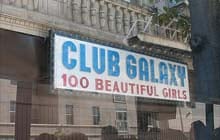
Yes, the books all say that Beth "Black Dahlia" Short was last seen alive in the Biltmore Hotel, but Esotouric's Real Black Dahlia tour explains that she actually continued her last night in the old Crown Grill, a lowdown Olive Street bar where Beth would regularly play third wheel on her girlfriends' dates with married guys. The Crown Grill is long gone, but in its place is Club Galaxy, one of a surprising number of taxi-dance halls to survive in downtown LA. It hasn't been a dime-a-dance for a long time and mariachi CDs have replaced the swing bands, but, if you've got 50 bucks to blow, exploring the last place Beth was seen alive can be a memorable experience.
· Club Galaxy, 9th and Olive Streets, Los Angeles, CA 90015.
7. The Aetherius Society
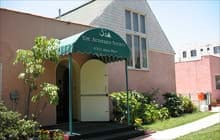
Bizarre religious nonconformity has been a part of LA culture for a long time, but The Aetherius Society - a modest row of pink bungalows in the heart of Hollywood - is one of the oddest examples. Founded in 1955 by the late George King, a yogi and human channel for cosmic wisdom, Aetherius is based upon a message of intergalactic peace that was conveyed through King by an extraterrestrial Christ, making it the first of the UFO religions. Public service is the main goal, with members engaging in prayer sessions where healing energy is stored in batteries until it can be released towards international crisis zones. Today all are welcome to attend lectures and prayer meetings, where they can watch a film of deep-space imagery synced to the alien voice of Christ, and then browse in the gift shop for sacred mountain memorabilia and tapes of King's lectures.
· The Aetherius Society, 6202 Afton Place, Hollywood, California 90028; +1 (323) 465 9652; aetherius.org
8. Grand Central Market
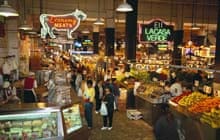
When bad civic planning lopped the top off old Bunker Hill 50 years ago, taking the city's grandest decaying Victorian homes and its beloved funicular Angels Flight with it, everyone said the Hill's "breadbasket" would soon follow. But the sprawling, block-wide Grand Central Market defied the cynics, and today you can still roam its wide aisles stocking up on fruit, spices and obscure cuts of meat, watching the passing crowd and enjoying wandering minstrels. Most vendors prepare quick, cheap meals - Mexican, Salvadoran or Chinese - and, near the Broadway entrance, there's a liquor stall doing a hearty trade in fortified wine. Buy an orange in memory of Bunker Hill novelist John Fante, who worked as a busboy in the lost Fay building (now the market's parking lot) and relied on the kindness of Japanese fruit vendors when broke.
· Grand Central Market, 317 South Broadway, Los Angeles, CA 90013; +1 (213) 624 2378; grandcentralsquare.com
9. Bob Baker Marionette Theater
Long ago, the building was a scenic shop where architectural backgrounds for early cinematic spectaculars were painted. Since 1961, it's been home to puppeteering visionary Bob Baker and his rotating crew of young apprentices, who have created thousands of the most astonishing string-controlled creatures imaginable, from singing watermelons to skeletal showgirls, day-glo space monsters to afro'd disco divas. Each daily performance is a time capsule into whichever year a particular show was crafted, with pop culture references, vintage musical cues and the lost artistry that makes objects of wood, foam, feathers and felt seem as alive as the kid kneeling on the rug to your left. Every show ends with a stop in the candy-striped party room, for complementary ice cream eaten with a wooden stick.
· Bob Baker Marionette Theater, 1345 W. First Street Los Angeles, CA 90026; +1 213 250 9995; bobbakermarionettes.com
10. Union Station
You've seen it in a hundred films, the cool white Spanish-cum-deco walls of the last great train station built in the US (1939). The name denotes the reality: after a fight that lasted decades, LA's corrupt city government managed to force independent rail companies Union Pacific, Santa Fe and Southern Pacific to unite their tracks. Of course, they first had to evict the Chinese citizens whose neighbourhood was on the land, shifting them three blocks west to a Disney-esque, neon-striped "New Chinatown" noticeably lacking in Old Chinatown's signature amenities: opium dens, whorehouses and gambling halls. Long-distance rail travel has long since become a novelty, but today Union Station is home to the subway, Amtrak and Metrolink stations, a bagel shop and upscale bar and restaurant Traxx (draught beer just $5, and folks rave about the crab cakes), not to mention a gigantic fish tank and varied art installations. Use it as a transit hub, or just drop in and rest your feet in one of the trademark deep leather benches.
· Union Station. 800 North Alameda St, Los Angeles, CA 90012
· For tour details and contact details, see esotouric.com
